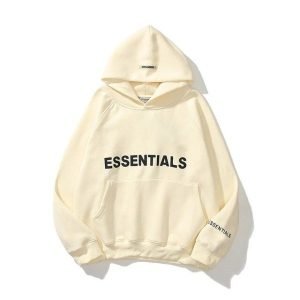In the ever-evolving realm of fashion, certain pieces Essentials Hoodie transcend their origins to become cultural mainstays. The Essentials Hoodie by Fear of God Essentials is one such piece. What began as a minimalistic approach to streetwear evolved into a global phenomenon. The journey of the Essentials Hoodie from a niche streetwear statement to a wardrobe essential speaks volumes about the shifting paradigms of style, comfort, and cultural relevance. As this hoodie quietly redefined casual luxury, it also reimagined how fashion intersects with everyday living.
The rise of Fear of God’s Essentials line was more than just another drop in the world of hypebeast culture. Jerry Lorenzo, the visionary behind the Fear of God brand, wanted to democratize luxury. With Essentials, he created garments that held the DNA of his high-end label but were accessible in both price and wearability. At the center of this mission was the Essentials Hoodie. Clean lines, neutral colors, oversized fits, and high-quality fabrics characterized the hoodie, giving it an identity that was both distinct and versatile. It wasn’t flashy, but it commanded attention through its effortless execution and aesthetic purity.
In the early days, the Essentials Hoodie was a symbol of street cred and subtle status. Streetwear enthusiasts appreciated the balance it struck between premium appeal and urban authenticity. Unlike other high-fashion streetwear hybrids that screamed for attention through loud logos or eccentric designs, the Essentials Hoodie offered a quiet form of rebellion. Its understated branding, often limited to tonal “ESSENTIALS” prints, reflected a deeper confidence. It wasn’t about proving status—it was about belonging to a community that valued thoughtful design over noise.
Over time, the hoodie gained traction beyond core streetwear circles. Celebrities and influencers began donning it in everyday settings—on coffee runs, in airport terminals, during interviews. This exposure contributed to the garment’s rise in mainstream popularity. The Essentials Hoodie became part of the new dress code for off-duty celebrities and stylish urbanites alike. It served as a perfect representation of the growing desire for fashion that blends form, function, and comfort. In this new landscape, athleisure and luxury no longer sat on opposite sides of the spectrum—they overlapped, and Essentials was right at the intersection.
One of the most interesting elements of the hoodie’s evolution was how it appealed to such a broad demographic. From high school students saving up for their first piece of real streetwear to seasoned professionals looking for a relaxed yet polished layer, the hoodie fit seamlessly into different lifestyles. Its unisex design and neutral palette made it even more adaptable. Essentials did not chase trends—it created a timeless silhouette that could transition from season to season without feeling dated. In doing so, it challenged the notion that fashion needed to be fleeting to be exciting.
The success of the Essentials Hoodie also highlighted the power of digital influence. Online platforms such as Instagram, TikTok, and fashion forums played a critical role in spreading the aesthetic. Hauls, fit pics, and reviews showcased how people styled the hoodie in unique and creative ways. This digital dialogue created a community around the garment—one that thrived on inspiration and relatability. It was no longer just a hoodie; it was a form of expression. Through every scroll and swipe, it solidified its status as a cultural staple.
What also contributed to the hoodie’s iconic stature was Fear of God’s commitment to quality. The Essentials line might have been priced more accessibly, but it never compromised on construction. The heavyweight cotton, double-layered hoods, ribbed trims, and attention to fit elevated the hoodie above typical fast-fashion fare. Every drop reinforced the brand’s reputation for excellence, even at a more attainable tier. Buyers knew they were investing in something that would not only last in their wardrobes but also in style relevance.
As the fashion industry continues to pivot towards sustainability and slow fashion, the Essentials Hoodie fits perfectly within this shift. It offers a sustainable mindset not through buzzwords, but through its timelessness. Rather than pushing consumers to cycle through trend-based wardrobes every season, it provides a foundational piece that can be worn repeatedly, styled differently, and appreciated continuously. This kind of conscious design is where fashion is heading—and Essentials is leading that direction by example.
Furthermore, the Essentials Hoodie has impacted more than just fashion. It represents a lifestyle movement—an ethos centered around simplicity, comfort, and quiet confidence. It redefines the relationship between luxury and accessibility. Instead of high prices serving as the sole marker of prestige, thoughtful design and functionality take precedence. In this way, the hoodie has become more than just a clothing item; it is a reflection of modern values and evolving consumer preferences.
Today, the Essentials Hoodie is not just a part of Fear of God’s story—it is part of a broader cultural narrative. It marks a pivotal point where fashion opened its doors wider, embraced inclusivity, and celebrated minimalism. It is a testament to how a simple piece, when designed with intention and authenticity, can resonate across generations and backgrounds. As trends come and go, the Essentials Hoodie stands firm as an enduring icon of casual style done right.
In conclusion, the journey of the Essentials Hoodie is one of quiet revolution. It disrupted without being disruptive, made a statement without shouting, and built a loyal following through design rather than hype. From its streetwear roots to becoming a staple in closets around the world, the hoodie has proven that simplicity, when executed thoughtfully, can leave a lasting mark. Its evolution is not just a fashion story—it’s a reflection of how culture, community, and comfort can come together to redefine what it means to be essential.



